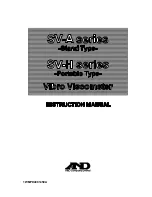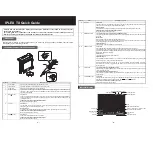
3
Effective 07 2020
Drawing No. LP1137
WIRING THE METER
Wiring Overview
Electrical connections are made via screw-clamp terminals
located on the back of the meter. All conductors should conform
to the meter’s voltage and current ratings. All cabling should
conform to appropriate standards of good installation, local codes
and regulations. It is recommended that the power supplied to
the meter (DC or AC) be protected by a fuse or circuit breaker.
Strip the wire, leaving approximately 0.3" (7.5 mm) bare lead
exposed (stranded wires should be tinned with solder.) Insert the
lead under the correct screw-clamp terminal and tighten until the
wire is secure. (Pull wire to verify tightness.) Each terminal can
accept up to one #14 AWG (2.55 mm) wire, two #18 AWG (1.02
mm), or four #20 AWG (0.61 mm).
Power Wiring
User Input Wiring
Input Wiring
USR COMM
US
R
+9-28 VDC
COMM
INP
+
PWR COMMON
+
-
DC Power
+9 to +28 VDC: +VDC
Power Common: -VDC
CAUTION
: 9 to 28
VDC power circuit is
not isolated from the
signal circuit.
CAUTION:
Power input common is NOT isolated from user and input commons. In order to preserve the safety of the
meter application, the power input common must be suitably isolated from hazardous live earth referenced voltage;
or input common must be at protective earth ground potential. If not, hazardous voltage may be present at the signal
or user inputs and input common terminals. Appropriate considerations must then be given to the potential of the
user and input commons with respect to earth ground; and the common of the plug-in cards with respect to input common.
Before connecting signal wires, the Input Range Jumper should be verified for proper position.
USR COMM
US
R
+9-28 VDC
COMM
INP
+
PWR COMMON
Sinking Logic
USR COMM
USR
The user input of the meter is
internally pulled up to +9 to
+28 V with 10 K resistance.
The input is active when it is
pulled low (<0 .7 V).
}
Connect external switching device between the
User Input terminal and User Input Common.
JUMPER
POSITION
MAX INPUT
VOLTAGE
200 mV ⁄ 2 VDC
75 VDC
20V ⁄ 200 VDC
250 VDC
Voltage Signal (self powered)
-
+
COMM
INP+
The remaining wiring information only applies to optional plug-in cards.
Setpoint (Output) Wiring
COM
N.C.
N.O.
COM
N.O.
N.C.
OSNK1
OSNK2
COM
Output Common is not isolated from DC Power Common.
Load must be wired between OSNK terminal and V+ of the
load supply.
COM
OSNK 1(2)
(30 V MAX.)
SINGLE SETPOINT RELAY PLUG-IN CARD
ELECTRICAL CONNECTIONS
DUAL SETPOINT N-FET OPEN DRAIN PLUG-IN CARD
ELECTRICAL CONNECTIONS






















